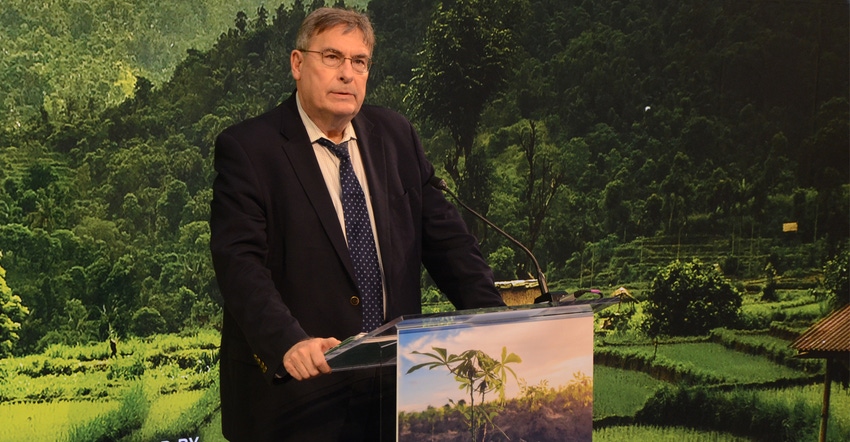
It is well-known to those in agriculture, but without water, there is no life. At a recent Heuermann Lecture wrapping up the 2019 Daugherty Water for Food Conference, Mark Rosegrant highlighted the "power of water" in addressing not only food security, but also health and economic empowerment.
As the agricultural sector prepares to feed the often-talked-about 9 billion-plus people in the world by 2050, there are a few hurdles to overcome, says Rosegrant, research fellow emeritus in the Director General's Office at the Washington, D.C.-based International Food Policy Research Institute (IFPRI). And, current food security needs can't be overlooked.
"In the last three years, hunger has actually increased globally according to the FAO [Food and Agriculture Organization of the United Nations]," Rosegrant says. "Most of the improvement is in Asia, whereas in Africa, you have static or even increasing hunger."
Much of the food demand is driven by population growth — with an expected growth of 2.5 billion people in Africa and 432 million in Asia between now and 2100.
Less than one-third of the world's harvested area is irrigated, but those areas also generate about 40% of global food production. And, water stress is increasing worldwide. About 36% of the world's population lives in regions characterized as water-stressed, while almost 40% of grain production is not sustainable in water use, according to an IFPRI analysis.
Rosegrant outlined several strategies for addressing water scarcity and global food demand.
Establishing water rights
One of the most important steps is establishing well-defined water and land rights — especially in developing countries. These rights, Rosegrant says, empower users by requiring consent and providing compensation for reallocations — in certain situations where water rights are moved from agricultural to rapidly growing urban areas, farmers don't receive compensation.
"The best way to do this is not rights to absolute amounts of water, but perpetual rights to a share of all allocations made in the river basin or irrigation system," Rosegrant says. "Each season, the share for the actual allocation should be based on available water, so there's equitable allocation of water rights during periods of shortages."
Of course, precision and irrigation technology also hold promise for using water more efficiently, but Rosegrant points out that systemwide water savings with new technology isn't always as easy to achieve as you might think. For example, while drip irrigation often makes the individual farm more efficient, it doesn't necessarily save water for the whole system, he says.
"You can save water if that water would otherwise evaporate unproductively, or flow to sinks, but in many cases, you may just divert water that would be used downstream by others," Rosegrant says. "A lot of studies, particularly in the Midwestern and western U.S., show increased water use when you adopt drip irrigation, because it increases the profitability of irrigation for individual farmers. Rather than saving water, they actually use more water to expand their area or improve yields."
"To achieve potential benefits through these technologies, you really need a water allocation system that recognizes those hydrological reallocations of reuse of water," he adds.
Focusing on developing world
There's also a need for increased investment in irrigation — an investment of about $8 billion to $12 billion per year through 2050 in the developed world. That might sound like a lot, but it's declined in recent years, as many optimal acres for irrigation in the developed world already are being irrigated. In the future, about 90% of the total increase in irrigation will be concentrated in developing countries.
That's why developments in farmer-led irrigation in developing countries will be important moving forward. However, in these areas, Rosegrant says large-scale irrigation likely isn't the best solution.
"It's very high-cost, not only in the development of the infrastructure for dams and canals, but in developing large-scale roads, rail and markets to remote areas," he says. "Small-scale irrigation looks much more promising. It's spurred by recent technological developments. It can be deployed at a much lower cost than large-scale. It's flexible for a diverse farming system and also changing hydrology. As climate change proceeds and rivers change course and rainfall changes patterns, these flexible new pumps can be moved along with that. You can't just pick up a dam and move it."
Rosegrant adds any solution must be tailored to the region's governance capabilities, agroclimatic conditions, water scarcity, competition for water and agricultural intensification.
"These will play out differently and have different priorities depending on these underlying conditions,” he says. "The solutions obviously are difficult, will take time, political commitment and money, and we have to move forward very quickly because of the growing challenges."
About the Author(s)
You May Also Like






